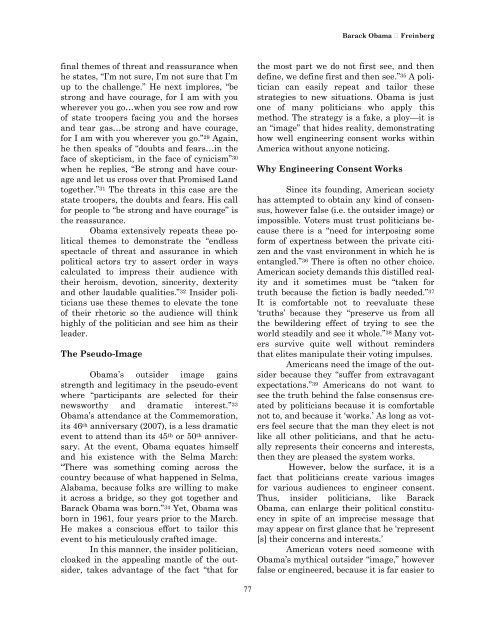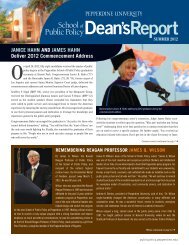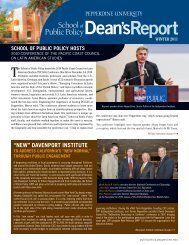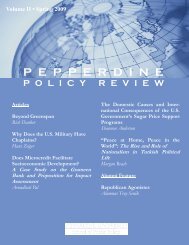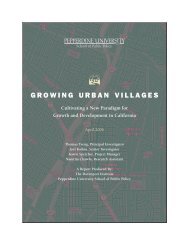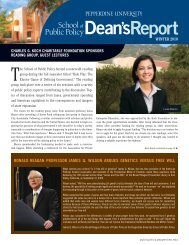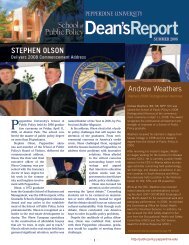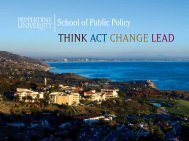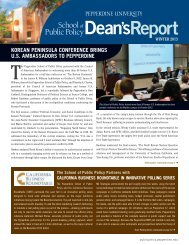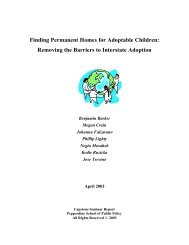Pepperdine University School of Public Policy
Pepperdine University School of Public Policy
Pepperdine University School of Public Policy
Create successful ePaper yourself
Turn your PDF publications into a flip-book with our unique Google optimized e-Paper software.
Barack Obama Freinberg<br />
final themes <strong>of</strong> threat and reassurance when<br />
he states, “I’m not sure, I’m not sure that I’m<br />
up to the challenge.” He next implores, “be<br />
strong and have courage, for I am with you<br />
wherever you go…when you see row and row<br />
<strong>of</strong> state troopers facing you and the horses<br />
and tear gas…be strong and have courage,<br />
for I am with you wherever you go.” 29 Again,<br />
he then speaks <strong>of</strong> “doubts and fears…in the<br />
face <strong>of</strong> skepticism, in the face <strong>of</strong> cynicism” 30<br />
when he replies, “Be strong and have courage<br />
and let us cross over that Promised Land<br />
together.” 31 The threats in this case are the<br />
state troopers, the doubts and fears. His call<br />
for people to “be strong and have courage” is<br />
the reassurance.<br />
Obama extensively repeats these political<br />
themes to demonstrate the “endless<br />
spectacle <strong>of</strong> threat and assurance in which<br />
political actors try to assert order in ways<br />
calculated to impress their audience with<br />
their heroism, devotion, sincerity, dexterity<br />
and other laudable qualities.” 32 Insider politicians<br />
use these themes to elevate the tone<br />
<strong>of</strong> their rhetoric so the audience will think<br />
highly <strong>of</strong> the politician and see him as their<br />
leader.<br />
The Pseudo-Image<br />
Obama’s outsider image gains<br />
strength and legitimacy in the pseudo-event<br />
where “participants are selected for their<br />
newsworthy and dramatic interest.” 33<br />
Obama’s attendance at the Commemoration,<br />
its 46 th anniversary (2007), is a less dramatic<br />
event to attend than its 45 th or 50 th anniversary.<br />
At the event, Obama equates himself<br />
and his existence with the Selma March:<br />
“There was something coming across the<br />
country because <strong>of</strong> what happened in Selma,<br />
Alabama, because folks are willing to make<br />
it across a bridge, so they got together and<br />
Barack Obama was born.” 34 Yet, Obama was<br />
born in 1961, four years prior to the March.<br />
He makes a conscious effort to tailor this<br />
event to his meticulously crafted image.<br />
In this manner, the insider politician,<br />
cloaked in the appealing mantle <strong>of</strong> the outsider,<br />
takes advantage <strong>of</strong> the fact “that for<br />
the most part we do not first see, and then<br />
define, we define first and then see.” 35 A politician<br />
can easily repeat and tailor these<br />
strategies to new situations. Obama is just<br />
one <strong>of</strong> many politicians who apply this<br />
method. The strategy is a fake, a ploy—it is<br />
an “image” that hides reality, demonstrating<br />
how well engineering consent works within<br />
America without anyone noticing.<br />
Why Engineering Consent Works<br />
Since its founding, American society<br />
has attempted to obtain any kind <strong>of</strong> consensus,<br />
however false (i.e. the outsider image) or<br />
impossible. Voters must trust politicians because<br />
there is a “need for interposing some<br />
form <strong>of</strong> expertness between the private citizen<br />
and the vast environment in which he is<br />
entangled.” 36 There is <strong>of</strong>ten no other choice.<br />
American society demands this distilled reality<br />
and it sometimes must be “taken for<br />
truth because the fiction is badly needed.” 37<br />
It is comfortable not to reevaluate these<br />
‘truths’ because they “preserve us from all<br />
the bewildering effect <strong>of</strong> trying to see the<br />
world steadily and see it whole.” 38 Many voters<br />
survive quite well without reminders<br />
that elites manipulate their voting impulses.<br />
Americans need the image <strong>of</strong> the outsider<br />
because they “suffer from extravagant<br />
expectations.” 39 Americans do not want to<br />
see the truth behind the false consensus created<br />
by politicians because it is comfortable<br />
not to, and because it ‘works.’ As long as voters<br />
feel secure that the man they elect is not<br />
like all other politicians, and that he actually<br />
represents their concerns and interests,<br />
then they are pleased the system works.<br />
However, below the surface, it is a<br />
fact that politicians create various images<br />
for various audiences to engineer consent.<br />
Thus, insider politicians, like Barack<br />
Obama, can enlarge their political constituency<br />
in spite <strong>of</strong> an imprecise message that<br />
may appear on first glance that he ‘represent<br />
[s] their concerns and interests.’<br />
American voters need someone with<br />
Obama’s mythical outsider “image,” however<br />
false or engineered, because it is far easier to<br />
77


